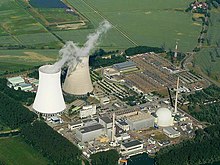Nuclear power plant


A nuclear power plant is a type of power station that generates electricity using heat from nuclear reactions. These reactions take place within a reactor. The plant also has machines which remove heat from the reactor to operate a steam turbine and generator to make electricity. Electricity made by nuclear power plants is called nuclear power.
Nuclear power plants are usually near water to remove the heat the reactor makes. Some nuclear power plants use cooling towers to do this. Nuclear power plants use uranium as fuel. When the reactor is on, uranium atoms inside the reactor split into two smaller atoms. When uranium atoms split, they give off a large amount of heat. This splitting of atoms is called fission.
The most popular atoms to fission are uranium and plutonium. Those atoms are slightly radioactive. The atoms produced when fuel atoms break apart are strongly radioactive. Today, fission only happens in nuclear reactors. In nuclear reactors, fission only happens when the reactors parts are arranged properly. Nuclear power plants turn their reactors off when replacing old nuclear fuel with new fuel.
There are about four hundred nuclear power plants in the world, with many in the United States, France, and Japan. Some famous accidents at nuclear power plants were the 2011 Fukushima nuclear disaster in Japan, 1986 Chernobyl disaster in Ukraine, and the 1979 Three Mile Island accident in the United States. An Anti-nuclear movement in Australia opposes the making of any nuclear power plants in the country.